Bilaspur is a city in Bilaspur district in the Indian state of Chhattisgarh, situated 111 km (69 mi) north of state capital, Raipur. It is the second-largest city (after raipur) in the state. It is the administrative headquarter of Bilaspur district. Chhattisgarh State High Court at Bilaspur privilege it to host the name 'Nyayadhani' ((Hindi: न्याय धानी) Law Capital) of the state. Bilaspur is known for its aromatic Doobraj rice, Samosa, Mango, handloom woven colorful soft Kosa silk Saris, and more for its rich, varied and colorful culture. Bilaspur District has a major contribution towards the naming of Chhattisgarh as "Dhaan Ka Katoora". Bilaspur was a part of Kalchuri dynasty of Ratanpur.The city, however, came into prominence around 1741, the year of the Maratha Empire invasion, when a Maratha official took up his abode there and began to build a fort, which however was never completed. The city was taken over by the British East India Company of Great Britain in the year 1854 when the then ruler of the region, Bhosale of Nagpur belonging to Maratha Empire died without an heir. The management of Bilaspur district was taken over by the British Government in 1818, before this it was under harsh, extortionist Marathaan rule for about 60 years. Bilaspur district was constituted in 1861, followed by Bilaspur municipality in 1867. Famines in the Bilaspur district were recorded by the British administration in 1828-9, 1834-5, 1845-6, 1868-9 and 1899–1900. In 1868-9 and 1899–1900, the rains failed almost completely, resulting in severe distress, migration and desertion of villages. After the 1868-9 famine there was prosperity for the next 25 years; but in 1895 there was a very poor harvest, followed in 1896 by a complete failure of crops, and severe famine continued throughout 1897. In that year the mortality rate was as high as one in six people. The famine of 1897 was followed by two favorable years; but in 1899 the monsoon failed completely and the rice crop was wholly destroyed. Bilaspur is located at 22.09°N 82.15°E.[1] It has an average elevation of 264 metres (866 ft). Bilaspur is situated on the banks of the rain-fed Arpa River, which originates from the high hills of the Maikal Range of central India. This dolomite rich region is surrounded by lush green forests in the north and the coal mines of Hasdeo valley in the east. Bilaspur district is surrounded by Koria District in north, Shahdol District of Madhya Pradesh,Mungeli District in West, Balauda Bazar-Bhata Para District in south and [[Korba ]] & Janjgir-Champa District in east.
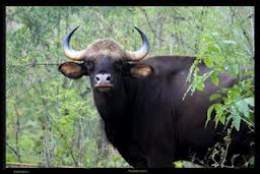
Achanakmaar Wildlife Sanctuary was constituted in 1975. It is a dense forest spread over an area of 555 km². About 40 kilometers from Bilaspur City Achanakmaar is the natural habitat for many wild animals including the tiger, leopard, chital, sambhar, bear, gaur etc. A trip to the forest is a very pleasant experience and it has all the ingredients to quench anybody's thirst for adventure. Plenty of tree cover, rough terrain, wild animals. Watch towers have been erected at several places where the wild animals of the jungle are regularly sighted. You can perch yourself on any of the towers and keep watch. To visit the forest you can join the guided tours into the forest from Bilaspur that are organized by the forest department. Alternately, you can explore also the jungle in your own vehicle.
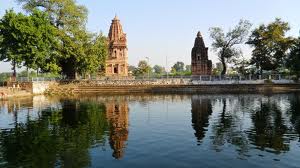
The temple town, Ratanpur, is situated about 25 kilometers from Bilaspur City on the Bilaspur - Ambikapur Highway. Today it is recognized as a major religious center of the region that has national acclaim. Devotees visit the Mahamaya temple all round the year to offer their prayers and seek blessings of the deity from far and wide. The glorious past of the place made it a prime candidate for historians and archeologist. The fort of Ratanpur has been taken up for restoration by the Archeological Survey of India. The findings here put it on the national archeological map. The ruins of the fort, the palace (Badal Mahal) and some of the old temples can still be seen here. The founder of Ratanpur, King Ratnadev also built the Mahamaya temple. The temple has the dual idol of goddesses - Saraswati and Laxmi. Mahamaya temple has gained recognition as a Sidh Peeth and is the most popular religious places in the Chhattisgarh state.
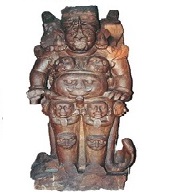
Talagaon is a small quite village, on the banks of Maniyari river. It is situated about 30 kms from Bilaspur, off the Bilaspur-Raipur Highway. This village came to limelight and got registered on the tourist map when the ancient picturesque Deorani-Jethani temples on the banks of the river were excavated. The highlight of Talagaon is the unique idol of Lord Shiva known as Rudrashiv (रुद्रशिव) which is in excellect condition. As for the rest of the temple, though the structures of the temples are not in very good shape whatever remains is evidence enough speaking volumes of the past magnificence of these temples. The carvings and statues on the walls of the temple depict stories of Lord Shiva and the entrances of the temples have several artistic statues of the deities. Off late, the area around the temples has been developed into a beautiful park keeping in view of the tourist traffic that the place has started attracting. New carvings are being done on the walls along the banks of river.
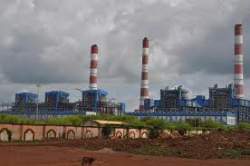
'Sipat' is a small developing town,approximately 22 kilometers away from Bilaspur, Chhattisgarh,the second largest city in Chhattisgarh. It has been in news due to setup of new power plant by NTPC Limited in that area. The project was started on 2001 by Indian former Prime Minister Mr. Atal Bihari Vajpayee.NTPC Sipat has total installed capacity of 2980 MW.NTPC Sipat has two stages: Stage-I comprises 3 units of 660MW each and Stage-II comprises 2 units of 500MW each.The thermal power generation in NTPC sipat Stage-II is based on "Super Critical Boiler Technology" which is the advanced technology in thermal power generation. NTPC Limited has helped this town in developing by providing business prospective in that area and by providing education, healthcare facilities.
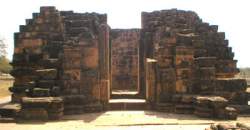
Malhar Situated about 30 kms from Bilaspur City, today Malhar is an important archaelogical site. The temples dating back to the 10th and 11th century have been excavated and salvaged here. Besides this, there are several sites here that have been marked for excavation by the Archaeology Department. Malhar used to be an important center during the Kulchuri regime. The archaelogical department has setup a museum where the many artifacts recovered during the excavations have been displayed. The twin villages of Malhar and Budikhar are littered with many old time artifacts which is very common place for the local residents. Amongst the prominent findings are the temples of Didneshwari, Pataleshwar and Dewari. The temple of Didneshwari is very popular and people from far and wide come to offer their prayers here. The beautiful black idol of Didneshwari Devi is really delight to see.
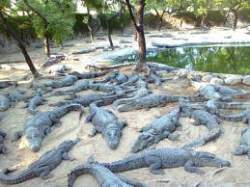
A large natural tank has been turned into a crocodile park near Kotmisonar village in Janjgir district ,approximately 30 kilometers away from Bilaspur. This step has been taken in order to save the villagers from being attacked by these amphibian creatures as well as protect them from being endangered species. The crocodile park in the Kotmi Sonar range houses nearly 150 crocodiles picked up from various village ponds in the vicinity. The park with a steel fencing was developed with a sole motive, to stop the crocodile menace in the village. The crocodiles attacked the villagers whenever they came near the ponds, once they found that their natural prey had reduced. A couple of villagers lost their lives and several others got injured. To stop this threat, the village Panchayats through the assistance of State's conservator of forests decided to house all the crocodiles in a separate vast lake.